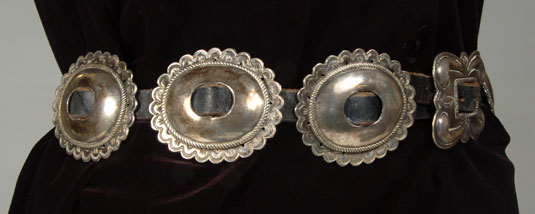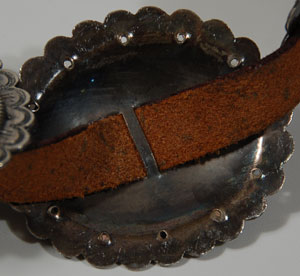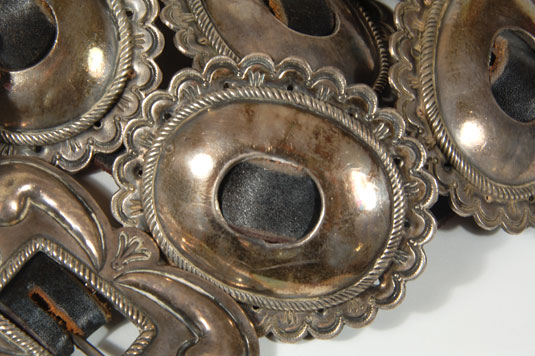Special Value Offer: Cochiti Pueblo Sterling Silver Concha Belt [SOLD]
+ Add to my watchlist Forward to Friend
- Category: Belts and Buckles
- Origin: Cochiti Pueblo, KO-TYIT
- Medium: sterling silver conchas, leather belt
- Size:
30” to 33” waist size;
3” x 2-1/2” concha size;
3” x 2-1/8” buckle - Item # C3276 SOLD
Special Value Offer: We have been authorized to reduce this belt by 42% from the original price of $3250 to a new price of $1875.

The Navajo are best known for production of concha belts, but pueblo silversmiths also made them. Joe Quintana and Silviano Quintana are known to have made them—some signed and others not. This concha belt was examined on October 18, 2013 by Cochiti jeweler Cippy Crazyhorse, son of Joe Quintana, who stated that he thought this was made by Silviano Quintana.
Julius Gans operated a curio store, Southwest Arts & Crafts, on the plaza in Santa Fe in the early 1900s. In those early years, he would drive to Gallup, New Mexico, to purchase jewelry from traders there. After a few years Gans was purchasing directly from pueblo artists in their homes. By the 1930s, Gans’ store was the largest retail curio operation in Santa Fe.
 In 1927, Gans was employing pueblo silversmiths to make jewelry on-site. Early jewelry was made from Mexican pesos. The silversmithing shop at Gans store held positions for twenty four jewelers. The silversmiths owned their own tools, but Gans provided silver and turquoise. Most of Gans’ smiths were from Cochiti Pueblo.
In 1927, Gans was employing pueblo silversmiths to make jewelry on-site. Early jewelry was made from Mexican pesos. The silversmithing shop at Gans store held positions for twenty four jewelers. The silversmiths owned their own tools, but Gans provided silver and turquoise. Most of Gans’ smiths were from Cochiti Pueblo.
Bench-work by pueblo and some Navajo continued until 1941 when Gans eliminated the workshop. Some of the smiths had commuted daily from Cochiti and others had moved to Santa Fe. Smiths were provided all materials and they were paid an hourly wage. The same wage was paid workers who worked from their homes.
Silviano and his wife were among those living in Santa Fe in 1938. Silviano served in World War II in the U. S. Army. He was awarded 1st and 2nd awards at the 1954 New Mexico State Fair.
The Santa Fe Indian School inaugurated classes for silversmiths in 1931 with Ambrose Roanhorse as the first instructor.
Reference and Recommended Reading: The Native American Curio Trade in New Mexico by Jonathan Batkin
Update: Cippy Crazyhorse, famous jeweler from Cochiti Pueblo examined this belt on October 18, 2013 and said he believed it was made by Silviano Qintana.

- Category: Belts and Buckles
- Origin: Cochiti Pueblo, KO-TYIT
- Medium: sterling silver conchas, leather belt
- Size:
30” to 33” waist size;
3” x 2-1/2” concha size;
3” x 2-1/8” buckle - Item # C3276 SOLD



